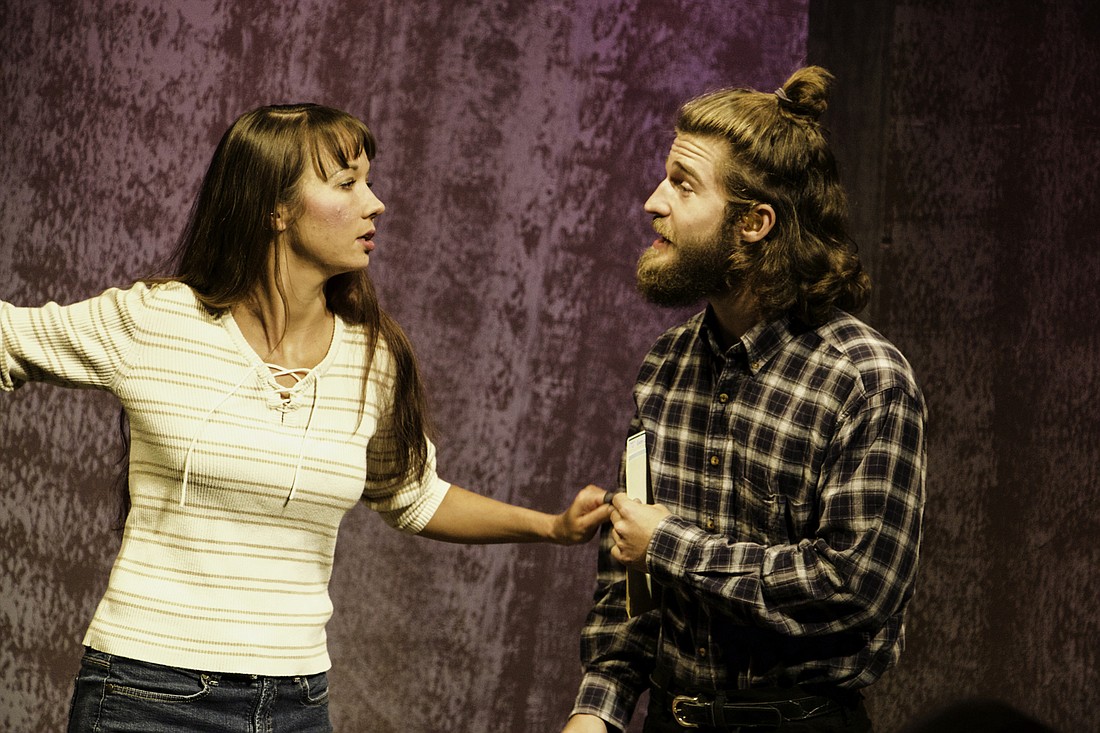- November 24, 2024
-
-
Loading

Loading

Corinne Woodland is a hard-working actor. She doesn’t shrink from challenging roles.
Her role as Sarah in “Children of a Lesser God” might prove the most demanding of all. Her mother, Kelly Woodland, is directing the production. Does that make it any easier?
“No,” she laughs. “It really doesn’t.”
The truth is, she didn’t expect to get the part at all.
Mark Medoff’s script specifies that deaf or hearing-impaired actors perform the roles of Sarah, Orin and Lydia in any professional production. Community theaters get some wiggle room. Even so, Kelly Woodland reached out to the local deaf community to cast these parts.
“Some of the auditions blew me away,” the director says. “Finding amazing talent wasn’t a problem. But community theater is seriously demanding in terms of time and transportation. A typical play takes 30 days out of your life — and the actors don’t get paid. Logistically, the non-hearing actors who’d auditioned just couldn’t work around it.”
Corinne Woodland had auditioned for the role of Sarah just in case. She was surprised to find that she got the part. After that, the hard work began.
To play her character, Corinne effectively had to master a second language. She had taken some American Sign Language classes in college and been part of a signing/singing chorus in “Big River.” To perform as Sarah, she had to take it to another level.
That meant intense training sessions with sign language instructors Kristi Auricchio and Sherry Kessel. In community theater, the average rehearsal time takes about 90 to 100 hours. Kelly’s ASL sessions added another 45 hours, spread out over three weeks.
“She put in a ton of time,” says Kelly. “And that’s not even counting the hours she practiced on her own.”
“I would never claim to be fluent,” Corinne says. “I had a basic ASL vocabulary before. Now, I’m functional at best.”
But basic ASL vocabulary was just the starting point.
Technically, Medoff’s play is an interlocking web of speech and gesture. During the performance, Jason Kimble (the actor playing James, the speech therapist) speaks both his dialog and the words the deaf characters sign. But he’s only pretending to translate. Actually, the script is in standard English. The actors in deaf roles had to translate their written dialogue into sign language. And then memorize it.
Two sets of words. With two sets of internal logic.
“ASL has a different syntax,” explains Corinne. “Subject, verb, modifier is the usual order — but it’s not rigid. If you’re not careful, you can sound like Yoda. One of my lines was, ‘Do you think you’re going to translate for me?’ I translated that into ASL as ‘Translate think you will?’”
On stage, it’s easy to get lost in translation. Corinne coped by ignoring the first commandment of acting school … Thou shalt listen.
“I learned when to turn off my senses,” she says. “It’s a strange game of avoiding eye contact and not watching people talk. I do some lip reading; my character can’t. So, I’ll look at the other actor’s hands and not in the eye. Or I’ll glance back and forth between their eyes and hands but avoid their lips. It’s very strange.”
Corinne adds that, “Jason has it way harder, bless his heart. I’m signing in ASL but not speaking. He speaks my lines for the audience — and the words are usually in a different order.”
Technical questions aside, a gestural performance can easily resemble an over-the-top silent movie actor. How’d Corinne keep from going too far?
“My mom said, ‘Don’t worry about it. Throw yourself into it — and don’t hold back. I’ll tell you if you go too far. You probably can’t.’”
Kelly and Corinne have done this before, of course. They enjoy working together, and they work just a little harder when they do.
“Corinne’s an inventive actor who’s grown up in the theater and absorbed the magic to the point of second nature,” says Kelly. “She’s one of the finest actors I’ve ever worked with. If she heard me, she’d say, ‘You’re just saying that because you’re my mom.’ But it’s true.”
“My mom and I work together pretty well,” says Corinne. “We’re both very passionate about the subject of this play. She’s got very high standards, but she’s open to input and collaboration. I know some ASL; she doesn’t. She’d say ‘How would you do it? What direction would you go?’”
Backstage collaboration is always a means to an end, even if it’s all in the family. The internal audience doesn’t count. The audience in the seats does. How have non-hearing theatergoers responded so far?
“During research and rehearsal, they helped us get it right,” says Kelly. “They were very touched when they saw the play. Some of the older ones remember the reality behind it. A few things have changed since then. Sadly, the core story of some people trying to force an identity on others is still as right as rain.”